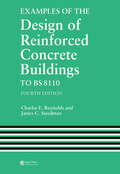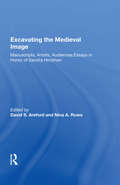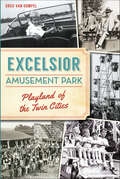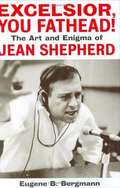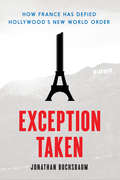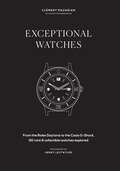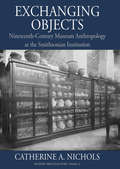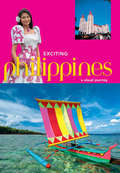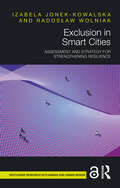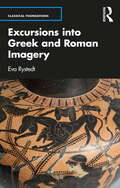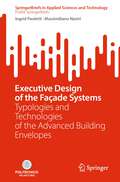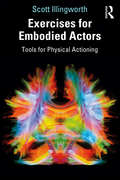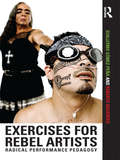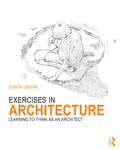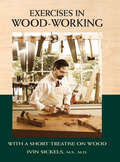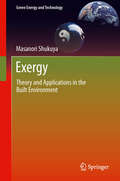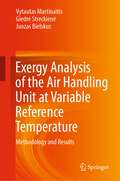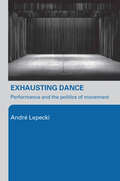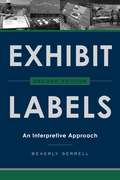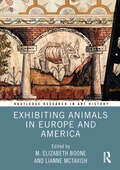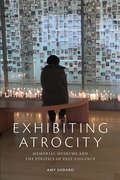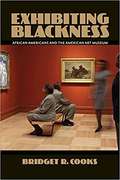- Table View
- List View
Examples of the Design of Reinforced Concrete Buildings to BS8110
by C.E. Reynolds J.C. SteedmanThe latest edition of this well-known book makes available to structural design engineers a wealth of practical advice on effective design of concrete structures. It covers the complete range of concrete elements and includes numerous data sheets, charts and examples to help the designer. It is fully updated in line with the relevant British Standards and Codes of Practice.
Excavating the Medieval Image: Manuscripts, Artists, Audiences: Essays in Honor of Sandra Hindman
by David S. ArefordMedieval images, especially manuscript illuminations, have long been treated independently of the contexts in which they were created. These beautiful miniature paintings, frequently valued as keepers of documentary evidence or as curious artistic commodities, have only recently become the focus of art historians concerned with new questions related to artistic working methods, audience and the status of the visual in the Middle Ages and the modern era. Excavating the Medieval Image argues that the illuminated image is best understood as thoroughly integrated in the material context of the manuscript - and thus, integrated in a cultural context of production and reception. Seen in this way, the illuminated manuscript becomes a kind of archaeological site, which must be carefully unearthed layer by layer. The fourteen essays gathered here are written by scholars of both medieval and Renaissance art history, and demonstrate varied methodological approaches that combine the pursuits of traditional connoisseurship and iconography with those of critical theory and historiography. In addition, the authors contribute more broadly to important interdisciplinary issues such as the study of gender, text and image, and the history of literacy and the book.
Excelsior Amusement Park: Playland of the Twin Cities (Landmarks)
by Greg Van GompelMinneapolis roared into the 1920s as a major metropolis, but it lacked the kind of outdoor amusement facilities common elsewhere across the country. In 1925, Fred W. Pearce introduced the Twin Cities to his "Picnic Wonderland." Crowds eagerly poured onto the shores of Lake Minnetonka by the trolley load. Luckily, Excelsior Park survived the Great Depression and World War II on the strength of its celebrity acts. Changes in the forms of transportation, combined with innovations in the outdoor entertainment industry such as Disneyland and an aging infrastructure, eventually forced the park to close its gates.
Excelsior, You Fathead!: The Art and Enigma of Jean Shepherd
by Eugene B. BergmannComprehensive biography of Jean Shepherd, radio personality and raconteur.
Exception Taken: How France Has Defied Hollywood's New World Order
by Jonathan BuchsbaumIn Exception Taken, Jonathan Buchsbaum examines the movements that have emerged in opposition to the homogenizing force of Hollywood in global filmmaking. While European cinema was entering a steady decline in the 1980s, France sought to strengthen support for its film industry under the new Mitterrand government. Over the following decades, the country lobbied partners in the European Economic Community to design strategies to protect the audiovisual industries and to resist cultural free-trade pressures in international trade agreements. These struggles to preserve the autonomy of national artistic prerogatives emboldened many countries to question the benefits of accelerated globalization.Led by the energetic minister of culture Jack Lang, France initiated a series of measures to support all sectors of the film industry. Lang introduced laws mandating that state and private television invest in the film industry, effectively replacing the revenue lost from a shrinking theatrical audience for French films. With the formation of the European Union in 1992, Europe passed a new treaty (Maastricht) that extended its legal purview to culture for the first time, setting up the dramatic confrontation over the General Agreement on Trade and Tariffs (GATT) in 1993. Pushed by France, the EU fought the United States over the idea that countries should preserve their right to regulate cultural activity as they saw fit. France and Canada then initiated a campaign to protect cultural diversity within UNESCO that led to the passage of the Convention on Cultural Diversity in 2005. As France pursued these efforts to protect cultural diversity beyond its borders, it also articulated "a certain idea of cinema” that did not simply defend a narrow vision of national cinema. France promoted both commercial cinema and art cinema, disproving announcements of the death of cinema.
Exception Taken: How France Has Defied Hollywood's New World Order (Film and Culture Series)
by Jonathan BuchsbaumIn Exception Taken, Jonathan Buchsbaum examines the movements that have emerged in opposition to the homogenizing force of Hollywood in global filmmaking. While European cinema was entering a steady decline in the 1980s, France sought to strengthen support for its film industry under the new Mitterrand government. Over the following decades, the country lobbied partners in the European Economic Community to design strategies to protect the audiovisual industries and to resist cultural free-trade pressures in international trade agreements. These struggles to preserve the autonomy of national artistic prerogatives emboldened many countries to question the benefits of accelerated globalization.Led by the energetic minister of culture Jack Lang, France initiated a series of measures to support all sectors of the film industry. Lang introduced laws mandating that state and private television invest in the film industry, effectively replacing the revenue lost from a shrinking theatrical audience for French films. With the formation of the European Union in 1992, Europe passed a new treaty (Maastricht) that extended its legal purview to culture for the first time, setting up the dramatic confrontation over the General Agreement on Trade and Tariffs (GATT) in 1993. Pushed by France, the EU fought the United States over the idea that countries should preserve their right to regulate cultural activity as they saw fit. France and Canada then initiated a campaign to protect cultural diversity within UNESCO that led to the passage of the Convention on Cultural Diversity in 2005. As France pursued these efforts to protect cultural diversity beyond its borders, it also articulated "a certain idea of cinema" that did not simply defend a narrow vision of national cinema. France promoted both commercial cinema and art cinema, disproving announcements of the death of cinema.
Exceptional Watches: From the Rolex Daytona to the Casio G-Shock, 90 rare and collectible watches explored
by Clément Mazarian'Behind a watch there are often hidden stories. Stories of those who made it and those who wore it. From the watchmaker to the diver, from the astronaut to the collector, from father to son - from buyer to thief even - a watch does not age. As it is handed on and, as it travels, from the Joux valley in Switzerland to the saleroom, from the depths of the ocean to the moon, and from the pages of a catalogue to those of this book, a watch only gains in substance.' Clément MazarianFrom mechanical watches to chronographs, quartz watches to divers', Exceptional Watches will transport you through time, uncovering the histories behind the most coveted watch models. Collector Clément Mazarian of Collection Personelle tells the stories of 90 era-defining watches from the early 1900s up to the present day, each one meticulously catalogued and accompanied by a stunning image from celebrated photographer Henry Leutwyler. Illustrated technical pages clearly explain the mechanics of these timepieces, while profiles of the watches give readers insight into their cultural histories. Exceptional Watches is a treasure trove for collectors and enthusiasts alike.Featured models include:- Rolex Submariner- Swatch Moonswatch - Jaeger-Lecoultre Reverso- Cartier Santos-Dumont - TAG Heuer Monaco- Philippe Patek Calatrava- Omega Flightmaster
Exceptional Watches: From the Rolex Daytona to the Casio G-Shock, 90 rare and collectible watches explored
by Clément Mazarian'Behind a watch there are often hidden stories. Stories of those who made it and those who wore it. From the watchmaker to the diver, from the astronaut to the collector, from father to son - from buyer to thief even - a watch does not age. As it is handed on and, as it travels, from the Joux valley in Switzerland to the saleroom, from the depths of the ocean to the moon, and from the pages of a catalogue to those of this book, a watch only gains in substance.' Clément MazarianFrom mechanical watches to chronographs, quartz watches to divers', Exceptional Watches will transport you through time, uncovering the histories behind the most coveted watch models. Collector Clément Mazarian of Collection Personelle tells the stories of 90 era-defining watches from the early 1900s up to the present day, each one meticulously catalogued and accompanied by a stunning image from celebrated photographer Henry Leutwyler. Illustrated technical pages clearly explain the mechanics of these timepieces, while profiles of the watches give readers insight into their cultural histories. Exceptional Watches is a treasure trove for collectors and enthusiasts alike.Featured models include:- Rolex Submariner- Swatch Moonswatch - Jaeger-Lecoultre Reverso- Cartier Santos-Dumont - TAG Heuer Monaco- Philippe Patek Calatrava- Omega Flightmaster
Exchanging Objects: Nineteenth-Century Museum Anthropology at the Smithsonian Institution (Museums and Collections #12)
by Catherine A. NicholsAs an historical account of the exchange of “duplicate specimens” between anthropologists at the Smithsonian Institution and museums, collectors, and schools around the world in the late nineteenth century, this book reveals connections between both well-known museums and little-known local institutions, created through the exchange of museum objects. It explores how anthropologists categorized some objects in their collections as “duplicate specimens,” making them potential candidates for exchange. This historical form of what museum professionals would now call deaccessioning considers the intellectual and technical requirement of classifying objects in museums, and suggests that a deeper understanding of past museum practice can inform mission-driven contemporary museum work.
Exchanging Objects: Nineteenth-Century Museum Anthropology at the Smithsonian Institution (Museums and Collections)
by Catherine A. NicholsAs an historical account of the exchange of “duplicate specimens” between anthropologists at the Smithsonian Institution and museums, collectors, and schools around the world in the late nineteenth century, this book reveals connections between both well-known museums and little-known local institutions, created through the exchange of museum objects. It explores how anthropologists categorized some objects in their collections as “duplicate specimens,” making them potential candidates for exchange. This historical form of what museum professionals would now call deaccessioning considers the intellectual and technical requirement of classifying objects in museums, and suggests that a deeper understanding of past museum practice can inform mission-driven contemporary museum work.
Exciting Philippines
by Elizabeth ReyesExciting Philippines explores many corners of this exotic country, from its bustling metro areas to the coastal beaches and mountain towns.
Exclusion in Smart Cities: Assessment and Strategy for Strengthening Resilience (Routledge Research in Planning and Urban Design)
by Izabela Jonek-Kowalska Radosław WolniakSmart Cities are fascinating, but they also have a dark side that little is said or written about. One issue is the possibility of generating various types of exclusion. For this reason, this book will develop principles for assessing the inclusiveness of Smart Cities and outline strategies for strengthening urban resistance to exclusion.The book will consider the essence, scale and types of exclusion and include analysis of inclusiveness in practice in the assessment and activities of Smart Cities. The research assesses Smart City literature, with particular emphasis on criticism of the Smart City concept and exclusion generated in smart urban structures, critically analyses the principles and indicators used in international inclusive Smart City rankings, highlights case studies on best practices for preventing exclusions in Smart Cities, and uses trend analysis to assess the scale and intensity of exclusion threats.This book can be used as a compendium of knowledge about exclusions in Smart Cities by both researchers and students, as well as all urban stakeholders, in particular city decision-makers.
Excursions into Greek and Roman Imagery (Classical Foundations)
by Eva RystedtThis book provides an enquiry into the distinguishing traits of Greek and Roman figural imagery. A detailed analysis of a wide range of material conveys an understanding of the figural imagery of classical antiquity as a whole, counterbalancing studies conducted on single genres. Through in-depth studies of six major production categories—Greek painted pottery, Roman decorated walls, Greek gravestones, Roman sarcophagi, Greek and Roman official sculpture, and Greek and Roman coins—the reader gains insights into the making of classical figural imagery. The images are explored within their contextual frameworks, paying attention to both functional purposes and pictorial traditions. Image–viewer relations offer a perspective that is maintained across the chapters. The bottom-up approach and the many genres of imagery discussed provide the basis for an extensive synthesis. Lavishly illustrated with over 100 images, Excursions into Greek and Roman Imagery provides a valuable resource for students of classical antiquity and history of art. The book also offers classical scholars, museum curators and others interested in classical art a fresh approach to the figural imagery of antiquity.
Executive Design of the Façade Systems: Typologies and Technologies of the Advanced Building Envelopes (SpringerBriefs in Applied Sciences and Technology)
by Ingrid Paoletti Massimiliano NastriThe book examines the typological and technological constitution of the principal advanced façade systems in the contemporary design and experimental scenario, proposing itself as a knowledge and operational tool currently lacking in the technical literature of the sector at an international level. It considers the field of advanced façade systems in a scientific way, constituting a support for the study and the executive design. The book investigates in detail, in an analytical form, the constitution of the components on a typological and geometrical, functional and constructive level, on the basis of the documents and knowledges acquired from the essential contemporary production and construction references. At the same time, the book is configured in a handbook form as a reference for understanding and application with respect to traditional and complex façade systems. For each main type of façade, the book provides explanations and scientific information for investigating and designing the advanced façades according to the characteristics of the mullions and transoms façade system (stick system), of the structural sealant glazing façade system, of the unit façade system, of the suspended façade system and of the double-skin façade system.
Exercises for Embodied Actors: Tools for Physical Actioning
by Scott IllingworthExercises for Embodied Actors: Tools for Physical Actioning builds on the vocabulary of simple action verbs to generate an entire set of practical tools from first read to performance that harnesses modern knowledge about the integration of the mind and the rest of the body. Including over 50 innovative exercises, the book leads actors through a rigorous examination of their own habits, links those discoveries to creating characters, and offers dozens of exercises to explore in classrooms and with ensembles. The result is a modern toolkit that empowers actors to start from their own unique selves and delivers specific techniques to apply on stage and in front of the camera. This step-by-step guide can be used by actors working individually or by teachers crafting the arc of a course, ensuring that students explore in physically engaged and dynamic ways at every step of their process.
Exercises for Rebel Artists: Radical Performance Pedagogy
by Guillermo Gómez Peña Roberto SifuentesIn Exercises for Rebel Artists, Guillermo Gomez-Pena and Roberto Sifuentes use their extensive teaching and performance experience with La Pocha Nostra to help students and practitioners to create ‘border art’. Designed to take readers right into the heart of radical performance, the authors use a series of crucial practical exercises, honed in workshops worldwide, to help create challenging theatre which transcends the boundaries of nation, gender, and racial identity. The book features: Detailed exercises for using Pocha Nostra methods in workshops Inspirational approaches for anyone creating, producing or teaching radical performance A step-by-step guide for large-scale group performance New, unpublished photos of the Pocha Nostra method in practice Exercises for Rebel Artists advocates teaching as an important form of activism and as an extension of the performance aesthetic. It is an essential text for anyone who wants to learn how use performance to both challenge and change.
Exercises in Architecture: Learning to Think as an Architect
by Simon UnwinArchitecture is a doing word. You can learn a great deal about the workings of architecture through analysing examples but a fuller understanding of its powers and potential comes through practice, by trying to do it... This book offers student architects a series of exercises that will develop their capacity for doing architecture. Exercises in Architecture builds on and supplements the methodology for architectural analysis presented in the author’s previous book Analysing Architecture (third edition, Routledge, 2009) and demonstrated in his Twenty Buildings Every Architect Should Understand (Routledge, 2010). The three books taken together deal with the three aspects of learning: description, analysis of examples, and practice. The book offers twelve exercises, each divided into a short series of tasks aimed at developing a particular theme or area of architectural capacity. The exercises deal with themes such as place-making, learning through drawing, framing, light, , uses of geometry, stage setting, eliciting emotional responses, the genetics of detail and so forth.
Exercises in Wood-Working: With a Short Treatise on Wood
by Ivin SickelsPut the Past to Work in Your Shop First printed in 1889, this book was written to educate college students in the craft and business of woodworking. Here, the original text is reprinted in its entirety, not only to help you discover late 19th-century practices in woodworking, but to help you make the most of traditional hand tools in the modern shop. As you work through a series of 39 exercises, you'll discover how to: Set up your shop and identify the tools every well-stocked hand-tool shop needs Effectively wield the most-used woodworking hand tools Use the various marketing gauges like a professional cabinetmaker Sharpen your tools - from plane blades to saw teeth Mark and cut the most-used joints in furniture making Use a frame saw (the quiet answer to the modern band saw) Make a door and drawer Install cabinet hardware including hinges and locks And more Plus, there are chapters on home building and repair of wooden fixtures, basic boat building, wood and traditional woodworking trades and more.
Exergy
by Masanori ShukuyaMany people, professionals and non-professionals alike, recognize that it is of critical importance to solve global energy and environmental issues. For this purpose, it is essential to have a scientific understanding of what is meant by the "energy" issue is and the "environmental" issue. The concept of "exergy" is a scientific concept that exactly fits. The concept of 'energy' is a scientifically-well established concept, namely 'to be conserved'. Then the question is what is really consumed. Exergy: Theory and Applications in the Built Environment is dedicated to answer this fundamental question by discussing the theory of "exergy" and by demonstrating its use extensively to describe a variety of systems in particular for built-environmental conditioning. Our immediate environmental space works within the flow of energy and matter in an "exergy-entropy" process, and the built environment can be designed with these energy & environmental issues in mind. Exergy: Theory and Applications in the Built Environment introduces readers who are not familiar with thermodynamics to the concept of exergy with a variety of discussion on the built-environmental space such as heating, cooling, lighting, and others. Readers, including students, researchers, planners, architects and engineers, will obtain a better picture of a sustainable built-environment.
Exergy Analysis of the Air Handling Unit at Variable Reference Temperature: Methodology and Results
by Vytautas Martinaitis Giedrė Streckienė Juozas BielskusThis book explore how exergy analysis can be an important tool for assessing the sustainability of buildings.Building's account or around 40 percent of total energy conditions depending on local climatic conditions. Due to its nature, exergy analysis should become a valuable tool for the assessment of building sustainability, first of all considering their scope and the dependence of their energy demands on the local environmental and climatic conditions.Nonetheless, methodological bottlenecks do exist and a solution to some of them is proposed in this monograph. First and foremost, there is the still-missing thermodynamically viable method to apply the variable reference environment temperature in exergy analysis. The monograph demonstrates that a correct approach to the directions of heat exergy flows, when the reference temperature is considered variable, allows reflecting the specifics of energy transformation processes in heating, ventilation, and air conditioning systems in a thermodynamically viable way. The outcome of the case analysis, which involved coordinated application of methodologies based on the Carnot factor and coenthalpies, was exergy analysis indicators – exergy efficiency and exergy destroyed – obtained for air handling units and their components. These methods can be used for the purposes of analysing and improving building technical systems that, as a rule, operate at a variable environment temperature. Exergy analysis becomes more reliable in designing dynamic models of such systems and their exergy-based control algorithms. This would improve the possibility to deploy them in building information modelling (BIM) technologies and the application of life cycle analysis (LCA) principles in designing buildings, thus improving the quality of the decision-making process. Furthermore, this would benefit other systems where variable reference environment plays a key role.This book is relevant to academics, students and researchers in the field of thermodynamic analysis considering HVAC equipment, building energy systems, energy efficiency, sustainable development of technical systems of energy, mechanics, and construction, as well as preservation of natural resources. Planners, designers, engineers of HVAC equipment, building energy systems, and developers of appropriate simulation tools (e.g., BIM) will also find it of use.
Exhausting Dance: Performance and the Politics of Movement
by Andre LepeckiThe only scholarly book in English dedicated to recent European contemporary dance, Exhausting Dance: Performance and the Politics of Movement examines the work of key contemporary choreographers who have transformed the dance scene since the early 1990s in Europe and the US. Through their vivid and explicit dialogue with performance art, visual arts and critical theory from the past thirty years, this new generation of choreographers challenge our understanding of dance by exhausting the concept of movement. Their work demands to be read as performed extensions of the radical politics implied in performance art, in post-structuralist and critical theory, in post-colonial theory, and in critical race studies. In this far-ranging and exceptional study, Andre Lepecki brilliantly analyzes the work of the choreographers: * Jerome Bel (France)* Juan Dominguez (Spain)* Trisha Brown (US)* La Ribot (Spain)* Xavier Le Roy (France-Germany)* Vera Mantero (Portugal) and visual and performance artists: * Bruce Nauman (US) * William Pope.L (US). This book offers a significant and radical revision of the way we think about dance, arguing for the necessity of a renewed engagement between dance studies and experimental artistic and philosophical practices.
Exhibit Labels: An Interpretive Approach
by Beverly SerrellBeverly Serrell presents the reader with excellent guidelines on the process of exhibit label planning, writing, design, and production. One of the museum field s leading consultants and label writers, Serrell has expanded upon her earlier book, Making Exhibit Labels, which has been a standard in the field since its initial publication. Exhibit Labels provides ample information on the art of label writing for diverse audiences, and explores the theoretical and interpretive considerations of placing labels within an exhibition. An examination of the impact of technological advances on the label-making process is also included. Exhibit Labels is a vital reference tool for all museum professionals.
Exhibiting Animals in Europe and America (Routledge Research in Art History)
by M. Elizabeth Boone Lianne McTavishThis edited volume, written by historians of art and visual culture who are working in the field of animal studies, seeks to understand how our ways of positioning (and ex-positioning) animals have separated us from the other-than-human animals that are an integral part of our interconnected world.Bringing together the visual and material culture of display with recent theoretical study on human–animal relations, the book draws attention to ways in which we might rethink this history and map pathways for the future. Defining the idea of exhibition and display broadly, chapters consider a diverse range of media, including paintings, anatomical sculpture, books, prints, and clothing; exhibition venues that take place in both the public and private realms; and key ideas such as looking at/looking back, seeing/being seen, and interspecies recognition. The authors cover topics that span the sixteenth through the early twentieth centuries and focus geographically on Europe and America, with significant content related to Canada, Indigenous America, and Latin America.The book will be of interest to scholars working in art history, visual studies, museum studies, animal studies, and environmental humanities.
Exhibiting Atrocity: Memorial Museums and the Politics of Past Violence
by Amy SodaroToday, nearly any group or nation with violence in its past has constructed or is planning a memorial museum as a mechanism for confronting past trauma, often together with truth commissions, trials, and/or other symbolic or material reparations. Exhibiting Atrocity documents the emergence of the memorial museum as a new cultural form of commemoration, and analyzes its use in efforts to come to terms with past political violence and to promote democracy and human rights. Through a global comparative approach, Amy Sodaro uses in-depth case studies of five exemplary memorial museums that commemorate a range of violent pasts and allow for a chronological and global examination of the trend: the U.S. Holocaust Memorial Museum in Washington, DC; the House of Terror in Budapest, Hungary; the Kigali Genocide Memorial Centre in Rwanda; the Museum of Memory and Human Rights in Santiago, Chile; and the National September 11 Memorial Museum in New York. Together, these case studies illustrate the historical emergence and global spread of the memorial museum and show how this new cultural form of commemoration is intended to be used in contemporary societies around the world.
Exhibiting Blackness: African Americans And The American Art Museum
by Bridget CooksIn 1927, the Chicago Art Institute presented the first major museum exhibition of art by African Americans. Designed to demonstrate the artists’ abilities and to promote racial equality, the exhibition also revealed the art world’s anxieties about the participation of African Americans in the exclusive venue of art museums―places where blacks had historically been barred from visiting let alone exhibiting. Since then, America’s major art museums have served as crucial locations for African Americans to protest against their exclusion and attest to their contributions in the visual arts. In Exhibiting Blackness, art historian Bridget R. Cooks analyzes the curatorial strategies, challenges, and critical receptions of the most significant museum exhibitions of African American art. Tracing two dominant methodologies used to exhibit art by African Americans―an ethnographic approach that focuses more on artists than their art, and a recovery narrative aimed at correcting past omissions―Cooks exposes the issues involved in exhibiting cultural difference that continue to challenge art history, historiography, and American museum exhibition practices. By further examining the unequal and often contested relationship between African American artists, curators, and visitors, she provides insight into the complex role of art museums and their accountability to the cultures they represent.
